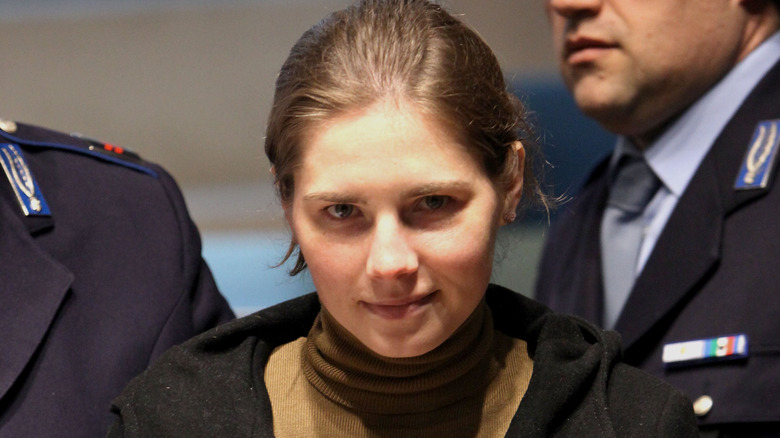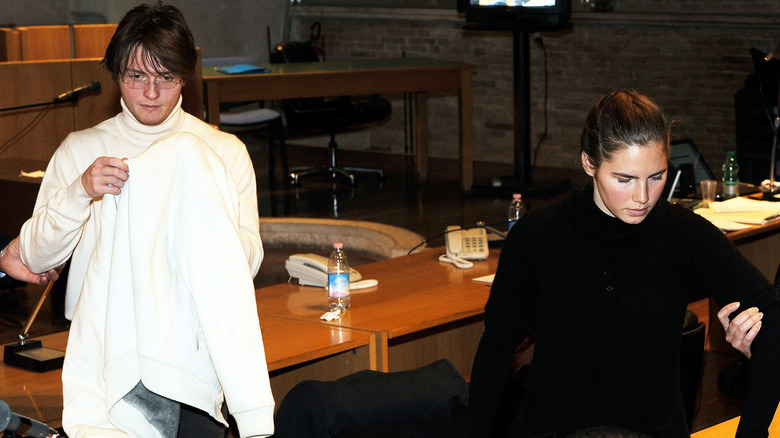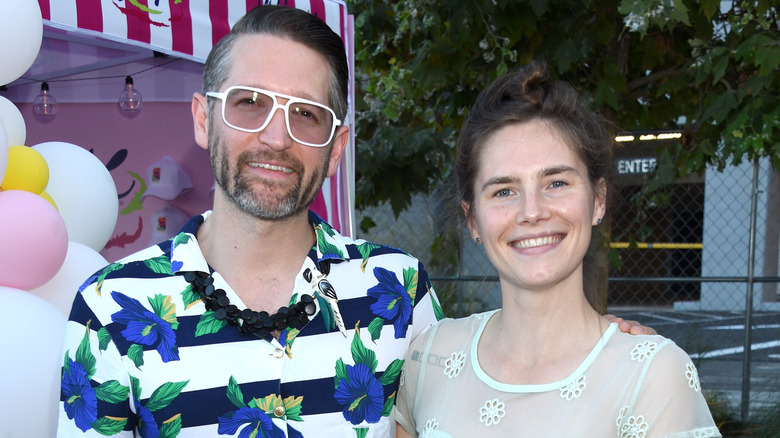Shady Amanda Knox Moments Revealed
This article contains descriptions of violence, homicide, and sexual assault.
In November 2007, British exchange student Meredith Kercher was found dead in her cottage in Perugia, Italy. Kercher's throat had been slit and she had been sexually assaulted. Kercher's roommate, American exchange student Amanda Knox, and Knox's then-boyfriend, Raffaele Sollecito, were considered suspects and eventually convicted of murder along with another student, Rudy Guede. Guede was convicted of murder in 2008 (via BBC). Knox and Sollecito stood trial and were eventually convicted the following year. After spending years in an Italian jail, Knox's initial conviction was overturned in 2011 and she returned home to Seattle, where she resides as of this writing.
Although Knox and Sollecito were both finally and fully exonerated in 2015 after protracted legal battles, there are reasons Knox was considered a suspect. There are also reasons why Knox was one of America's most infamous alleged criminals for years. Her behavior during the investigation was strange at times, and she hasn't exactly lived a quiet life since her return home. Let's reopen the curious case of the so-called "Foxy Knoxy" as we examine some of Amanda Knox's shadiest moments.
If you or anyone you know has been a victim of sexual assault, help is available. Visit the Rape, Abuse & Incest National Network website or contact RAINN's National Helpline at 1-800-656-HOPE (4673).
The 2020 U.S. election turned Amanda Knox into a controversial comedian
After being acquitted in a high-profile murder case that made international news for years, logic would suggest that Amanda Knox would want to live a private, low-profile life in Seattle. If nothing else, no one would blame her for staying off of social media, right? Actually, completely wrong. Knox has verified Twitter and Instagram accounts on which she frequently posts.
In November 2020, Knox had some very shady thoughts on the U.S. presidential election, and decided to tweet them. "Whatever happens, the next four years can't be as bad as that four-year study abroad I did in Italy, right?" she wrote. At the very least, her words are insensitive because her plight involved the death of Meredith Kercher, and Twitter users let her know it. "Utterly disgusting thing to say let alone think!" one Twitter user replied. "This is so disgusting. No care for all the people terrified for their lives over the next 4 years," another critic replied, adding, "No care for the memory of Meredith Kercher, or her family who will surely hear of this vile tweet."
We are also confused as to why Knox thought this was an appropriate sentiment — or even an acceptable joke — to put out into the world, but she hasn't responded to her detractors, or even deleted the tweet as of this writing.
Amanda Knox did splits after she was questioned by police
Amanda Knox has been acquitted of Meredith Kercher's murder, but there are reasons why she was considered a suspect early on in the case that go beyond the fact that the women were roommates. Some of her behavior during the investigation and beyond can only be described as strange. For example, Italian police officer Giacinto Profazio claimed Knox allegedly did gymnastics after being questioned by investigators about the murder. "I was also told that she did the splits and a cartwheel in one of the rooms at the station," Profazio testified (via Evening Standard). "Then later, after being questioned all night, she burst into tears." ABC News reported that a female officer first testified about this alleged behavior.
Knox admits to some of the odd interrogation room exercise, but told Diane Sawyer for ABC News that she was "just stretching." "As far as cartwheels or splits, I never did a cartwheel. I did do the splits. And then later on [the officer] claimed that I was doing a whole number of gymnastics — cartwheels, back walkovers. I did the splits, and that's once," Knox said. When Sawyer asked her if Knox could understand why that choice was "strange" to people Knox replied, "What's strange is why these things got mischaracterized."
Clearly, doing splits in a police station does not make Knox a murderer, but it does make us scratch our heads about why she thought it was appropriate.
Did Amanda Knox and Raffaele Sollecito's PDA go too far?
Amanda Knox's weird behavior at the police station involved more than just doing splits. ABC News reported that she sat on her then-boyfriend Raffaele Sollecito's lap at one point and that they were inappropriately affectionate beyond that, including making playful gestures towards one another and kissing until a police officer reportedly intervened.
Knox was apparently also somehow famished in the immediate aftermath of her roommate's murder, at least, according to her diary which was supposedly excerpted by Italian journalist Fiorenza Sarzanini. In her book, "Amanda and the Others" (via another book on the topic, "The Murder of Meredith Kercher"), Sarzanini quoted the following passage from Knox's personal journal: "I'm dying of hunger. I really want to say that I could murder a pizza but that doesn't seem right."
There is also an infamous video of Knox and Sollecito kissing just feet from her house, a crime scene. Per ABC News, the odd video footage features just "three quick kisses," followed by Knox appearing downtrodden afterwards. Of the moment, Knox told Diane Sawyer she was just staring off thinking about fate. "My friend had been murdered and it could [have] just as easily been me," she said. Of course, it's understandable to seek comfort during a traumatic time, but the reports of PDA in front of police only further perpetuated the salacious media portrait of Knox, described by NBC News as "a sexual aggressor, a femme fatale."
Amanda Knox seemed to lack empathy for Meredith Kercher and her friends
Testifying in court during Amanda Knox's trial, Meredith Kercher's friend, Robyn Butterworth, said (via Evening Standard), "While I was there I found Amanda's behavior very strange. She had no emotion while everyone else was upset." While it may seem unfair to judge Knox's behavior in the immediate aftermath of a traumatic event, her actions did have an effect on others who were also grieving the loss of Kercher.
For example, when a friend commented that they hoped Kercher did not suffer while dying, Knox was quoted as responding, "How could she not? She got her f***ing throat slit," (via ABC News). When confronted by Diane Sawyer about the remark, Knox said, "I was angry. I was pacing, thinking about what Meredith must have been through." She also admits that she regrets what she said to Kercher's grieving friends. "I wish I could have been more mature about it, yeah."
Knox shed some more light on the subject in a 2017 essay for Westside Seattle, writing that although Kercher "was [her] closest friend in a new and exciting time in [their] lives," she felt she has "never been allowed to mourn her." Sadly, between the trauma of the loss, and the ordeal of being accused of the crime and everything that followed, Knox felt disconnected from her friend almost immediately after her death and for years afterwards.
Was Amanda Knox too casual in court?
Murder trials are serious business, which is why observers were confounded by Amanda Knox's apparently cavalier attitude toward her own — particularly in terms of her attire. During a Valentine's Day 2009 appearance, she wore jeans and a t-shirt displaying the song title "All You Need Is Love" (via The Seattle Times). This might be true, but it's not exactly respectful to appear so laid back when you are on trial for murder, even if you're innocent. Knox explained her wardrobe choice to ABC News: "It was another [moment] of my naive immaturity. I didn't realize how very intensely I was being scrutinized."
The Seattle Times also compared Knox's courtroom behavior to that of her ex-boyfriend, Raffaele Sollecito, noting "Knox's calm demeanor" and "chats with the interpreter during breaks." Sollecito, on the other hand, "appeared more tense and kept a lower-profile; he faces the cameras only when briefly waving to his family sitting in front of them." The differing postures, at the very least, contributed to the sensational media portrait of Knox that overshadowed the entire trial.
While Knox may write off her perceived flippancy to being youthfully aloof, criminologist Saverio Fortunato told The Seattle Times there could be an explanation for Knox's behavior. "It could be a sign of malaise and confusion," Fortunato said. "Facing the wounds of a trial can push you to adopt a certain behavior to fight off the fear, which can be interpreted from the outside as inappropriate."
Amanda Knox admitted to odd behavior at the crime scene, too
Amanda Knox acted strangely throughout all stages of Meredith Kercher's murder investigation. She even admits to odd behavior in her 2013 book, "Waiting to Be Heard" in which she describes her awkwardness while accompanying Italian authorities to the crime scene. Per excerpts published in The New York Times, Knox writes that "she sang out 'Ta-dah' and thrust out her arms 'like the lead in a musical,'" a gesture meant "to ease the tension for [herself], because this was so surreal and terrifying." There were also rumors that "Knox and Sollecito were found with a mop and bucket outside the bloody crime scene," however Rolling Stone reported that it could not confirm such details in either official Italian police reports or with the trials prosecutor.
Mop story aside, Knox was 21 at the time of Kercher's murder. It is a young age, but certainly old enough to know that police investigations are not only important, but also that every little thing she did during it was going to be taken into account.
An expert breaks down 'red flags' in Amanda Knox's ABC News interview
Amanda Knox's memoir, "Waiting to Be Heard," was released on April 30, 2013 and an interview with Diane Sawyer for ABC News aired the same day (via The Hollywood Reporter). Since it was Knox's first interview since being released from Italian prison in 2011, the eyes of the country were on it.
Body language and communications expert Vanessa Van Edwards went a step further and analyzed Knox's body language in a blog post, revealing what she called "red flags" that indicated Knox's "body language did not match her verbal answers." For example, Van Edwards noted that Knox verbally answers "No," but affirmatively "nods" when asked if she was in her home on the night of Meredith Kercher's murder. Van Edwards also noted possibly deceptive behavior when Knox pauses and "deeply swallows" when asked, "Do you know anything else you have not told police, that you have not said in this book?"
Van Edwards also pointed out that Knox's words don't match her facial expressions all the time. When she says, "it could very well have been me," meaning she could have been murdered instead of Kercher, her face is stoic, not emotive or reflective of such a contemplation. Again, none of this means Knox is guilty, but it certainly qualifies as shady for an expert to point out how ones words don't align with one's body language.
Amanda Knox compared her situation to the plight of Irish people
Amanda Knox's Diane Sawyer interview for ABC News may have raised red flags for some people, but it's not her only interview to raise eyebrows. The only way we can describe one of her international appearances is just plain weird. Knox appeared on "The Ray D'Arcy Show" in Ireland in 2018 and compared her experience in Italy to the plight of the Irish people. Then, she sang an Irish fight song. Yes, seriously. We'll let her explain.
"I got letters from lots of Irish people who really understood like, 'Of course, authority taking advantage of a vulnerable person and spinning it in a bad way? Of course! We know that.' Like, they sent me Irish rebel songs and everything," she said. She then proceeded to sing one with the lyrics "Come out you black and tan, come out and fight me like a man." D'Arcy called Knox's singing "the oddest thing I've ever witnessed," and it's hard to argue with that assessment. After all, no how you describe Knox's behavior at times, it should never be lost that she is a public figure because Meredith Kercher is dead. That is nothing to sing about.
The odd way Amanda Knox promoted her return to Italy
Eight years after being exonerated of Meredith Kercher's murder, Amanda Knox traveled to Italy to participate in an event for the Italy Innocence Project. In addition to the crush of news coverage of Knox's return abroad, Knox promoted it as well. In a Medium essay, Knox revealed that she would "speak about wrongful convictions and trial by media." On social media, she took a lighter tone. "3 Days till I return to Italy for the first time since leaving prison," she captioned an Instagram post featuring a photo of her pretending to hang from a cliff. "Feeling frayed, so I made my own inspirational workplace poster. 'Hang in there!' Just imagine I'm a kitten."
The Kercher family apparently wasn't impressed with Knox's strange playfulness. In a statement to The Guardian, their lawyer, Francesco Maresca, described Knox's behavior as attention-seeking, and declared her return to Italy for a criminal justice conference "inappropriate." Maresca continued, "The murder is a tragic memory for the Kercher family ... It's also an injustice for them as they still don't know the full truth."
A few years prior, Meredith's sister, Stephanie Kercher echoed this same sentiment in an essay for the Daily Mail, and even hinted that the family doubts Knox's innocence. "It is difficult to come terms with not knowing exactly what happened that night," she wrote, adding, "Whether you believe the guilt or innocence of the accused there are still contradictions and discrepancies in the judge's summary."
Amanda Knox's Life today
Amanda Knox returned to Seattle when she was exonerated of Meredith Kercher's murder in 2011. In 2013, she authored a memoir about her harrowing experience abroad, titled "Waiting to Be Heard." She works as a journalist now, and has been working with The Innocence Project, per In Touch.
Upon returning to the U.S., Amanda Knox lived quietly for about a year until she made her private life, well, very public. She has public, active Instagram and Twitter accounts, which may seem strange for a public figure who once decried the media obsession with her polarizing international murder case. However, Knox explained her decision to make her social media accounts visible to the public in a 2019 Medium essay. "I [made my social media accounts public] because I just wanted to have what every other person around me had, the freedom to shout into the wind and say, 'Here I am,'" she wrote. "The freedom to strike up an unexpected conversation with a friendly digital stranger."
Knox also married fellow journalist Christopher Robinson (above) in February 2020 during a "Star Wars" and Renaissance-themed wedding at an Elks Lodge in Washington, per E!. Knox and Robinson co-host a podcast called "Labyrinths," where they "delve into stories of getting lost and found again through compassionate interviews, philosophical rants, and playful debate with fascinating people," per the program's official description. She's certainly made brave decisions since returning home.











